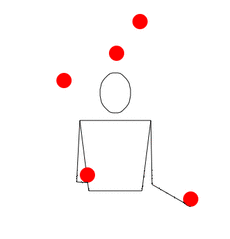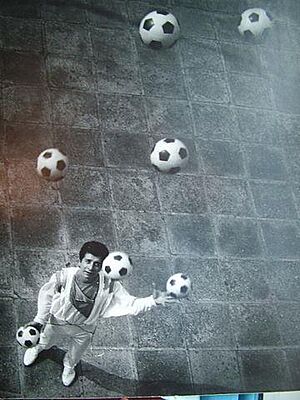Cascade (juggling) facts for kids
 |
|
| Minimum prop #: 3 | |
| Difficulty: Cascade: 2/10, 3 Reverse cascade: 4/10, Tennis: 2/10, Half-Shower: 3/10 (note: difficulty ratings are arbitrary and subject to change) | |
| Siteswap: 3 | |
| Shannon: 12 | |
| Period: 1 | |
| Parity: odd | |
| Notes: symmetrical, asynchronous |
The cascade is one of the most basic and important juggling patterns. It's usually the first trick most jugglers learn, especially with three balls. In a cascade, the objects you're juggling (like balls) follow a cool figure-eight or hourglass path in the air.
Imagine the balls crossing over each other in a smooth, continuous flow. Each time you throw a ball, it goes under the ball that was just thrown. This creates a rhythmic movement where your hands take turns throwing and catching. It's like a dance between your hands and the juggling props!
Contents
How Many Things Can You Juggle?
Three-Ball Cascade
The three-ball cascade is where most jugglers begin. To start, you hold two balls in one hand and one ball in your other hand.
Here's how it works:
- You throw one ball from the hand with two balls. It goes in an arc towards your other hand.
- Before that ball lands, you must throw the ball from the receiving hand. This ball also goes in an arc, back towards your first hand.
- You keep repeating this! Each hand takes a turn throwing a ball and catching another.
When you juggle a cascade, you catch the balls on the outside of the pattern. Then, you move your hand closer to the middle to throw the next ball. This movement makes your left hand move in a counterclockwise circle and your right hand move in a clockwise circle.
You can do the cascade with many different things, not just balls! People often use clubs, rings, or scarves. Scarves are great for beginners because they fall slowly, giving you more time to think and react.
The cascade pattern works best with an odd number of objects, like 3, 5, or 7. If you're juggling an even number of objects, like 2, 4, or 6, the basic pattern is called a fountain.
Juggling More Than Three Balls
When you juggle more objects, like five or seven balls, the cascade still uses the same basic idea: throw one ball before catching the next. But with more balls, you need to throw them higher. This gives you more time to make all the throws and catches.
To start a cascade with many balls, you usually throw all but one ball from alternating hands before you catch anything. This helps you get all the balls moving in the pattern.
Reverse Cascade
The reverse cascade is a cool variation where the balls follow the same path as a regular cascade, but it's like watching it in reverse! Instead of throwing the balls under each other, you throw them over each other.
Here's the main difference:
- In a regular cascade, you throw the ball from near your body's middle, and it goes under the other balls. You catch it on the outside.
- In a reverse cascade, you throw the ball from the outside, and it goes over the other balls. You catch it closer to the middle of your body.
This means your hands move in the opposite direction compared to a regular cascade. Your left hand moves clockwise, and your right hand moves counterclockwise.
The reverse cascade is a bit harder than the regular cascade. It's often rated as a 4 out of 10 for difficulty, while the regular cascade is a 2 out of 10. It's also one of the simpler patterns you can do with your arms crossed!
Tennis Juggling
Many juggling tricks mix parts of the regular cascade and the reverse cascade. One example is called tennis.
In tennis, two of the balls are juggled in a regular cascade (thrown under). But one special "tennis" ball is thrown over the others, going back and forth like a tennis ball over a net!
There's also reverse tennis. In this trick, two balls are thrown over (like a reverse cascade), while one ball is thrown under (like a regular cascade).
Images for kids










